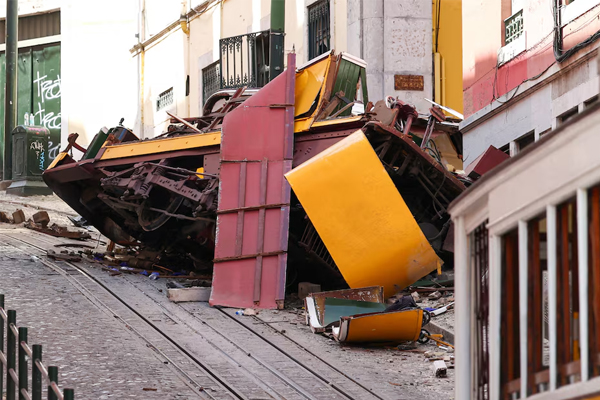
The derailment of a historic Lisbon cable car that killed at least 16 people has shattered the city’s “old charm” image, exposing the strain of the Portuguese capital’s ageing infrastructure beneath its tourist-packed streets.
In Wednesday’s crash, the railcar left the track at a turn and hit a building just metres from its twin at the bottom of the steep 265-metre slope, leaving a mangled wreckage with bodies trapped inside. The traction cable linking them had snapped.
Jorge Silva, vice-president of the Portuguese association of civil protection technical experts, said a car made of a more modern material, such as carbon fibre, rather than metal and wood – the same design used since 1914 when the line was electrified – would have made the crash less violent and deadly.
“The pieces are rigid enough to withstand oscillation and normal service, but they’re not designed to withstand the impact in the event of a derailment, become twisted, leaving the passengers more exposed,” he said.
Lisbon’s trams running up and down its steep hills also date back to the mid-20th century and have a similar structure, he said.
“Investment should be made in renovating the carriages, using more modern materials, even if preserving their historic shape,” he said.
Investigation Underway
Silva said an investigation would show to what extent the pendulum cable system played a role in the crash.
The time-tested technology has had to cope with a tripling in the number of passengers on the “Gloria” funicular line in the past decade to more than 3 million people annually, as tourism booms.
The two cars, each capable of carrying around 40 people, alternately climb the slope and descend as electric motors pull the cable linking them.
Manuel Leal, leader of the Fectrans union, told local TV that workers had complained that problems with the tension of the cable had made braking difficult, but that it was too early to say if that was the cause of the crash.
The municipal transport company Carris said all maintenance protocols have been carried out. Silva said more rigorous and frequent maintenance and inspection were likely to be needed to prevent future accidents with the current heavier use.
But modernisation attempts in the earthquake-prone city have also concerned engineers and architects, fearing a reoccurrence of the Great Lisbon Earthquake of 1755.
Many houses in downtown Lisbon built not long after 1755 with then-pioneering interconnected internal structures and pillars to withstand quakes have lately been adapted in a way that could compromise their original anti-seismic structures, several engineering experts told Reuters.
While newer houses built after 1958 must have seismic-resistant structures by law, no anti-seismic reinforcement is required for old buildings being renovated.
(With inputs from Reuters)




